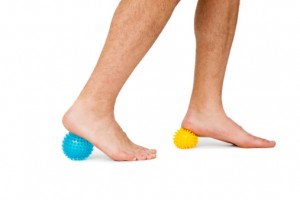

 Heel spurs with plantar fasciitis can cause heel pain while standing or walking. A heel spur is a pointed bony outgrowth of heel bone. If located underneath the sole, it is associated with plantar fasciitis. Heel spurs can occur on their own or triggered by an alternative cause.
Heel spurs with plantar fasciitis can cause heel pain while standing or walking. A heel spur is a pointed bony outgrowth of heel bone. If located underneath the sole, it is associated with plantar fasciitis. Heel spurs can occur on their own or triggered by an alternative cause.
A heel spur can also be located at the back of the heel, under the heel, or beneath the sole of the foot. Heel spurs at the back of the heel are often related to the Achilles tendon and can be most painful when pushing off the ball of the foot.
As mentioned, if pain is experienced underneath the sole of the foot, most likely the heel spur is related to plantar fasciitis. This type of pain is worsened when stepping down on the heel.
Heel spurs and plantar fasciitis can occur separately or together and can even be results of other conditions, such as arthritis, ankylosing spondylitis, and diffuse idiopathic hyperostosis. In some cases, heel spurs may be symptomless and a patient may only find out about their heel spur while undergoing an X-ray.
A heel spur is often causeed by calcium deposits, which develop underneath the heel bone over the course of a few months. Heel spurs can cause strains on the foot muscles and ligaments and over time can lead to tearing of the membrane that covers the heel bone.
Risk factors for heel spurs include waking gait abnormalities (for example, too much stress on the heel), running or jogging, poorly fitted shoes lacking support, and being overweight. Other risk factors include older age, diabetes, standing for long periods of time, frequent short bursts of physical activity, and having either flat feet or high arches.
Heel spurs can go symptomless, but some symptoms experienced may include chronic pain that worsens during walking or running, and a dull pain that begins severe in the morning and dulls down the day goes on. Over time, as the plantar fasciitis progresses and the heel bone continues to deteriorate, the pain will worsen.
In order to better treat the pain associated with heel spurs, here are some effective home remedies you can try.
As mentioned, some exercises can actually benefit heel spur pain. Here are some exercises you can try to improve heel spur pain.
To prevent further injury, always ensure you are wearing proper footwear.
Achilles heel pain from Achilles tendinitis and bursitis, treatment, and prevention
Achilles tendinitis and Achilles bursitis are two types of heel pain that result from inflammation in the Achilles tendon. The Achilles tendon is a band of tissue that connects the calf muscles at the back of the lower heel to the heel bone. Continue reading…
Sprained ankle risk may be influenced by foot positioning during walking, running
Sprained ankle risk may be influenced by foot positioning during walking and running. The researchers at the University of Georgia found that the position of the foot when walking or running could greatly affect the likelihood of spraining the ankle. Continue reading…
Copyright © www.orthopaedics.win Bone Health All Rights Reserved